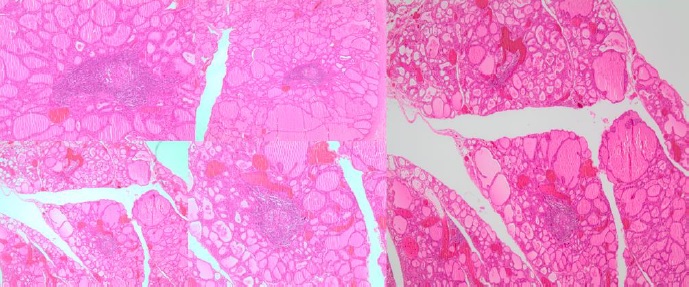Abstract
Objective: To describe the case of a pregnant patient with Graves’ disease who presented inadequate response to antithyroid medications with the aim to present the alternative therapeutics options such as cholestyramine, steroids, potassium iodide, plasmapheresis and thyroidectomy. Material and methods: 18 years-old-female patient, with 25-week pregnancy and history of Graves’ disease for 2 years, treated with high doses of methimazole and propranolol. Results: Post-surgical evolution was satisfactory; patient was discharged with levothyroxine 100 mg/day treatment. At the 39th week of gestation, a healthy female baby was born, weighting 3200 grams with a normal neonatal TSH 6.21 mU/ml (0-15). Conclusions: Thyroidectomy at the end of the second trimester in pregnant women with Graves’ disease may be a favorable therapeutic alternative in case of inadequate response to medical treatment.
2. Nathan N, Sullivan SD. Thyroid disorders during pregnancy. Endocrinology and Metabolism Clinics of North America. 2014. Vol. 43,p. 573–97.
3. Brent GA. Graves ’ Disease. N Engl J Med. 2008; 12;358 (24) 2594–605.
4. Hainet D, Martínez V, Mercedes ID, Caridad D, Ii HH. Hipertiroidismo y embarazo Hyperthyroidism and pregnancy. Revista Cubana de Endocrinología 2012;23(3):299–305.
5. Nachum Z, Rakover Y, Weiner E, Shalev E. Graves ’ disease in pregnancy : Prospective evaluation of a selective invasive treatment protocol. Am J Obstet Gynecol. 2003;189 (1): 159-65.
6. Krajewski DA, Burman KD. Thyroid disorders in pregnancy. Vol. 40, Endocrinology and Metabolism Clinics of North America. 2011. p. 739–63.
7. Carlos J, Ferrater G, Corrales JJ. Artículos especiales Guía clínica para el diagnóstico y el tratamiento de la disfunción tiroidea subclínica en la gestación. 2009;56(2):85–91.
8. Graves hyperthyroidism AND pregnancy :A clinical Review. Clin Diabetes endocrinolo. 2010;16(1):90033.
9. Cooper DS, Laurberg P. Hyperthyroidism in Pregnancy. Lancet Diabetes Endocrinol. 2013;1(3):238–49.
10. Grigoriu C, Cezar C, Grigoras M, Horhoianu I, Parau C. Management of hyperthyroidism in pregnancy. J Med Life. 2008;1(4):390–6.
11. Alexander AEK, Pearce EN. 2017 Guidelines of the American Thyroid Association for the Diagnosis and Management of Thyroid Disease during Pregnancy and the Postpartum. 2017. Thyroid. 2017.
12. Stagnaro-Green A. Overt hyperthyroidism and hypothyroidism during pregnancy. Clin Obstet Gynecol. 2011;54(3):478–87.
13. Ross DS, Burch HB, Cooper DS, Greenlee MC, Laurberg P, Maia AL, et al. 2016 American Thyroid Association Guidelines for Diagnosis and Management of Hyperthyroidism and other causes of Thyrotoxicosis. Thyroid [Internet]. 2016;26(10):1–272.
14. Glinoer D. The Systematic Screening and Management of Hypothyroidism and Hyperthyroidism During Pregnancy. Trends Endocrinolo Metabl.1998;9(10): 403-11.
15. Lazarus JH. Management of hyperthyroidism in pregnancy. Endocrine. 2014; Vol. 45; p. 190–4.
16. Laurberg P, Andersen SL. Antithyroid drug use in early pregnancy and birth defects: Time windows of relative safety and high risk?. European Journal of Endocrinology. 2014; Vol. 171.
17. Hoon Yim C. Update on the Management of Thyroid Disease during Pregnancy. org Endocrinol Metab. 2016;31:386–91.
18. Li H, Zheng J, Luo J, Zeng R, Feng N, Zhu N, et al. Congenital anomalies in children exposed to antithyroid drugs in-utero: A meta-analysis of cohort studies. PLoS One. 2015;10(5):1–11.
19. Laurberg P, Andersen SL. Pregnancy and the incidence, diagnosing and therapy of Graves’ disease. European Journal of Endocrinology. Vol. 175, 2016. p. R219–30.
20. Yoshioka W, Miyauchi A, Ito M, Kudo T, Tamai H, Nishihara E, et al. Kinetic analyses of changes in serum TSH receptor antibody values after total thyroidectomy in patients with Graves’ disease. Endocr J. 2016;63(2):179.
21. Laurberg P, Bournaud C, Karmisholt J, Orgiazzi J. Management of Graves’ hyperthyroidism in pregnancy: Focus on both maternal and foetal thyroid function, and caution against surgical thyroidectomy in pregnancy. European Journal of Endocrinology.Vol. 160, 2009. p. 1–8.
22. Alsanea O, Clark OH. Treatment of graves ’ disease : the advantages of surgery. Endocrinol Metab Clin North Am. 2000;29(2):321–37.
23. Li X, Liu G, Ma J, Zhou L. Risk of congenital anomalies associated with antithyroid treatment during pregnancy: a meta-analysis. Clinics (Sao Paulo). 2015;70(6):453–9.
24. Li H, Zheng J, Luo J, Zeng R, Feng N, Zhu N, et al. Congenital anomalies in children exposed to antithyroid drugs in-utero: A meta-analysis of cohort studies. PLoS One. 2015;10(5).
25. Bilir BE, Atile NS, Kirkizlar O, Ko Y, Akpinar S, Sezer A, et al. Effectiveness of preoperative plasmapheresis in a pregnancy complicated by hyperthyroidism and anti-thyroid drug-associated angioedema. Gynecological Endocrinology. 2013;3590(5):508–10.
This journal is registered under a Creative Commons Attribution 4.0 International Public License. Thus, this work may be reproduced, distributed, and publicly shared in digital format, as long as the names of the authors and Pontificia Universidad Javeriana are acknowledged. Others are allowed to quote, adapt, transform, auto-archive, republish, and create based on this material, for any purpose (even commercial ones), provided the authorship is duly acknowledged, a link to the original work is provided, and it is specified if changes have been made. Pontificia Universidad Javeriana does not hold the rights of published works and the authors are solely responsible for the contents of their works; they keep the moral, intellectual, privacy, and publicity rights.
Approving the intervention of the work (review, copy-editing, translation, layout) and the following outreach, are granted through an use license and not through an assignment of rights. This means the journal and Pontificia Universidad Javeriana cannot be held responsible for any ethical malpractice by the authors. As a consequence of the protection granted by the use license, the journal is not required to publish recantations or modify information already published, unless the errata stems from the editorial management process. Publishing contents in this journal does not generate royalties for contributors.



